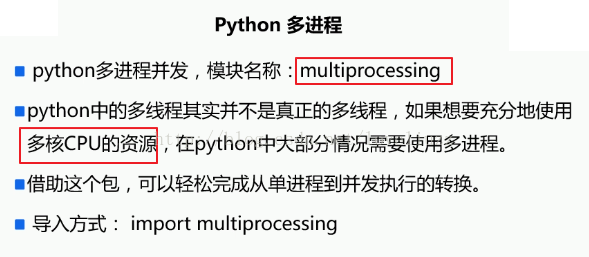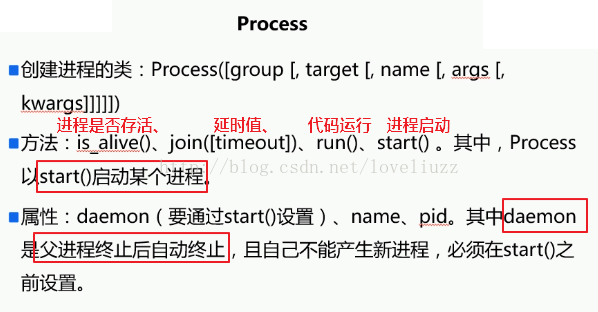本文实例讲述了python3.5多进程原理与用法。分享给大家供大家参考,具体如下:

进程类:process

示例及代码:

(1)创建函数作为单进程
|
1
2
3
4
5
6
7
8
9
10
11
12
13
14
15
16
17
18
19
|
#!/usr/bin/env python# -*- coding:utf-8 -*-# author:zhengzhengliuimport multiprocessingimport time#创建函数并将其作为单个进程def worker(interval): n = 5 #进程数 while n>0: print("the time is :{0}".format(time.ctime())) #初始化时间 time.sleep(interval) #睡眠时间 n-=1if __name__ == "__main__": # 创建进程,target:调用对象,args:传参数到对象 p = multiprocessing.process(target=worker,args=(2,)) p.start() #开启进程 print("进程号:",p.pid) print("进程别名:",p.name) print("进程存活状态:",p.is_alive()) |
运行结果:
进程号: 6784
进程别名: process-1
进程存活状态: true
the time is :wed nov 1 10:59:03 2017
the time is :wed nov 1 10:59:05 2017
the time is :wed nov 1 10:59:07 2017
the time is :wed nov 1 10:59:09 2017
the time is :wed nov 1 10:59:11 2017
(2)创建函数作为多进程
|
1
2
3
4
5
6
7
8
9
10
11
12
13
14
15
16
17
18
19
20
21
22
23
24
25
26
27
28
29
|
#!/usr/bin/env python# -*- coding:utf-8 -*-# author:zhengzhengliuimport multiprocessingimport time#创建函数作为多进程def work1(interval): print("work1...") time.sleep(interval) print("end work1...")def work2(interval): print("work2...") time.sleep(interval) print("end work2...")def work3(interval): print("work3...") time.sleep(interval) print("end work3...")if __name__ == "__main__": p1 = multiprocessing.process(target=work1,args=(1,)) p2 = multiprocessing.process(target=work2,args=(2,)) p3 = multiprocessing.process(target=work3,args=(3,)) p1.start() p2.start() p3.start() print("the number of cpu is %d:"%(multiprocessing.cpu_count())) #打印cpu核数 for p in multiprocessing.active_children(): #循环打印子进程的名称和pid print("子进程名称:%s,子进程pid:%d" %(p.name,p.pid)) print("ending....") |
运行结果:
the number of cpu is 4:
子进程名称:process-2,子进程pid:7108
子进程名称:process-1,子进程pid:1896
子进程名称:process-3,子进程pid:7952
ending....
work3...
work1...
work2...
end work1...
end work2...
end work3...
注:先运行主进程的内容,再运行子进程
(3)将进程定义成一个类
|
1
2
3
4
5
6
7
8
9
10
11
12
13
14
15
16
17
18
19
|
#!/usr/bin/env python# -*- coding:utf-8 -*-# author:zhengzhengliuimport multiprocessingimport time#将进程定义为一个类class clockprocess(multiprocessing.process): def __init__(self,interval): multiprocessing.process.__init__(self) #重构了process类里面的构造函数 self.interval = interval def run(self): #固定用run方法,启动进程自动调用run方法 n = 5 while n>0: print("the time is {0}".format(time.ctime())) time.sleep(self.interval) n-=1if __name__ == "__main__": p = clockprocess(2) p.start() |
运行结果:
the time is wed nov 1 11:31:28 2017
the time is wed nov 1 11:31:30 2017
the time is wed nov 1 11:31:32 2017
the time is wed nov 1 11:31:34 2017
the time is wed nov 1 11:31:36 2017
(4)queue(队列)实现多进程数据传输
|
1
2
3
4
5
6
7
8
9
10
11
12
13
14
15
16
17
18
19
20
21
22
23
|
#!/usr/bin/env python# -*- coding:utf-8 -*-# author:zhengzhengliuimport multiprocessing#queue是多进程安全的队列,可以使用实现多进程之间的数据传递def writer_proc(q): try: q.put(1,block=false) #put方法插入数据到队列中 except: passdef reader_proc(q): try: print(q.get(block=false)) #get方法从队列中读取并删除一个元素 except: passif __name__ == "__main__": q = multiprocessing.queue() writer = multiprocessing.process(target=writer_proc,args=(q,)) writer.start() reader = multiprocessing.process(target=reader_proc,args=(q,)) reader.start() reader.join() writer.join() |
运行结果:
1
希望本文所述对大家python程序设计有所帮助。
原文链接:https://blog.csdn.net/loveliuzz/article/details/78411458










